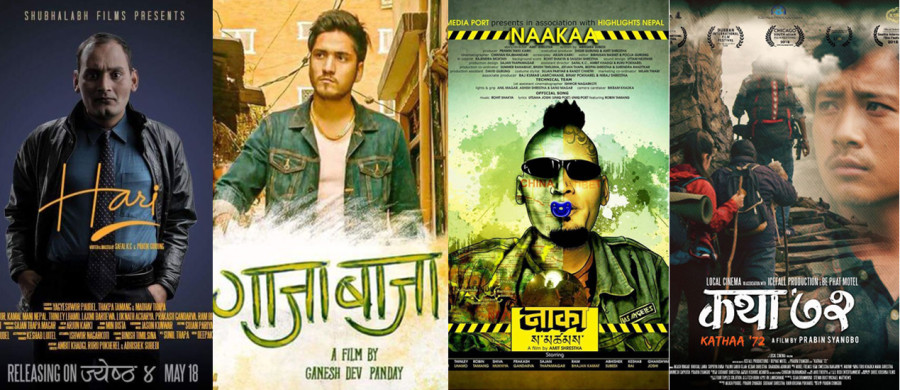Special Supplement
Nepalis movies are making money. But Nepali cinema has an identity crisis.
The Nepali film industry had a few films to be proud of this year as art-house filmmakers switched into the mainstream.
Timothy Aryal
Rajesh Hamal and Nikhil Upreti might have been replaced by Dayahang Rai and Anmol KC but the Nepali film industry continues to suffer from a seemingly incurable identity crisis. It’s hard to define the texture and look of Nepali mainstream cinema without reference to film industries around the neighbourhood. The formula a large swathe of Nepali filmmakers still follow—four songs and maybe a couple of action sequences—is the personification of a Bollywood film.
And lately, a number of films, such as Chhakka Panja 3 and Jai Bhole, have also started to borrow elements—from editing tics and soundtrack—from South India’s Tamil film industry.
But aside from the aforementioned films and their ilk, there are some filmmakers, however few in number they may be, who are attempting something new and original. This past year saw a number of such movies—Hari, Naaka, Gaaja Baja, and Katha ’72, all of which can be categorised as Nepali independent films.
Globally, a film is considered an ‘independent’ film if it is made with private financing, rather than studio backing. But that doesn’t necessarily hold true in Nepal’s case since there are no big-name studios that fund films. There are, however, many production houses, such as Aama Saraswati Movies, A One Time Cinema and Gopi Krishna Movies, that are financially strong and continue to produce relatively high-budget film series such as Chhakka Panja and Nai Nabhannu La.
Over the years, the independent film has developed into a genre of sorts itself. The American film critic Richard Brody defines modern-day indie films as such, “An independent film is one that’s made within the arm’s reach of the filmmakers, that’s experiential—that the filmmakers make in order to see not just the world at large but also their own place in it. Independent films are made for the filmmaker to learn from. In effect, they’re student films—films by students of life, who aren’t professing but searching for their own place in the world and in filmmaking itself.”
Brody’s definition fits films like Hari, Naaka, Gaaja Baja and Katha ’72, all of which have a distinctive plotline that is free of modern mainstream conventions such as a leading man and leading lady, an overabundance of drama and a plethora of songs and action sequences. Instead, these films are the result of an artistic vision at work. These films were directed by relative newcomers who had a story to tell. Hari, the best of the lot, was daring enough to veer away from established narrative forms, expertly juxtaposing elements of realism and surrealism to produce a film that was cerebral and stunning to look at. The young filmmakers behind this project presented a quirky, original film which was long overdue in the industry; essentially, they had an artistic goal in hand.
Likewise, Gaja Baja too was a trailblazer in its own right, for it brought a new genre—the stoner comedy—to the Nepali film industry. The film is about three ‘stoners’ who hang around in Kathmandu’s alleys, smoke weed and speak in local, flamboyant lingo, reminding one of the ‘tyape types’ one might encounter in one of the Capital’s dusty chowks. This film is what one might call the much-talked-about ‘organic’ Nepali film. While Naaka was a welcome crime drama set along the Nepal-China border.
“What all these films had in common is that they were personal expressions born out of a zeal to tell a story,” said Abhimanyu Dixit, a film reviewer. “The characters they featured were not dramatic caricatures but those that looked like they were hand-picked from our own society, which puts them starkly against the cinematic norm established in mainstream Nepali cinema.”
“Although not without faults,” Dixit went on, “these films were made with the vision of a team that wanted to present their product in a tone different to what had been seen on Nepali screen before. These films might have pleased a small number of cinephiles but ironically, they largely went unnoticed. They couldn’t market their product well, because there were no superstars.”
What is easy to glean from this current fix is that there seems to be a gap between the objective of the directors and the expectation of the audience, argues Naresh Kumar KC, who has tried his hand at both indie and commercial features (Dying Candle, Romeo and Muna). “The common perception among filmgoers in Nepal is that a film should have eye-catching images and more importantly entertaining, with a few jokes and one-liners sprinkled here and there,” KC says. “Nepali audiences go to the theatre to escape from the humdrum of daily existence and get a dose of entertainment—that’s the reason why films like Chhakka Panja have seen massive commercial success.”
But there also seems to be a matter of financing at play here. Given that these original indie films are made with a limited budget, they can’t do a heavy promotion like the big production house-backed features. Prawin Takki Karki, the producer of Naaka, argues that the problem with indie films is a lack of robust promotion and a broader reach. “It’s not that the audiences do not appreciate these films, they do,” Karki says. “But we don’t have ample resources to let them know what our film is about.”
Karki also cites a pointed indifference from the Film Development Board. “Most of these films are easily overshadowed by high-budget films, and Bollywood and Hollywood blockbusters. It seems that we need a separate cinema house to exclusively showcase indie films for a longer run,” he said.
However, it’s not that only indie films are suffering and most mainstream films are raking in crores.
“There seem to be two streams of filmmaking in Nepal currently. One is poorly-made films and another, passionately-made films,” says director and critic Manoj Pandit. “Hari, for example, provided a breath of fresh air to the Nepali audience. But we cannot revel in its merits. We live in an age of globalisation and films like Hari from around the world are just a click away.”
For critics like Pandit, both indie and commercial do not seem to have a distinct identity; they are both poorer iterations of international fare. Even indie films, though unique for Nepal, are not doing anything new in world cinema, says Pandit. “We need to think about the identity of a Nepali film. What seems to be lacking in Nepali film circle is a conversation. We need to ask, what is the characteristic of a Nepali film?” he says.
The Nepali film industry had a few films to be proud of this year, but a new trend has also become visible: directors who started out making films with originality and artistic vision quietly mingling into the mainstream. Khagendra Lamichhane and Dipendra K Khanal, both artistic independent directors at one time, both came out with hit comedies this year. These films were popular but they had little artistic merit.
The danger now is that other independent directors will follow in Lamichhane and Khanal’s footsteps and abandon artistic cinema completely. It remains to be seen whether the indie Nepali film will continue to survive in the years to come.




 13.12°C Kathmandu
13.12°C Kathmandu










